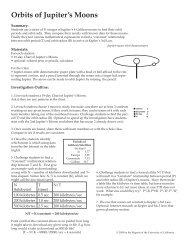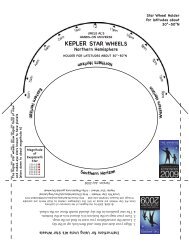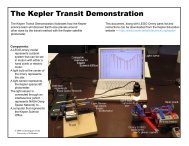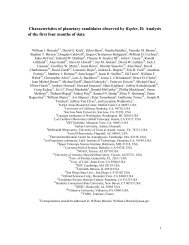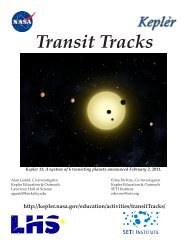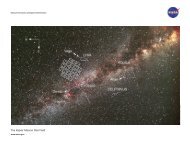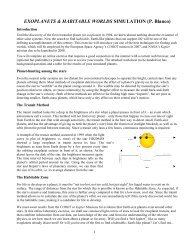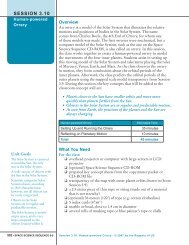Poster Abstracts - Kepler - NASA
Poster Abstracts - Kepler - NASA
Poster Abstracts - Kepler - NASA
- No tags were found...
Create successful ePaper yourself
Turn your PDF publications into a flip-book with our unique Google optimized e-Paper software.
POSTER ABSTRACTSP1022. POSTER SESSION IIDYNAMICS OF PROTOPLANETARY DISKS IN STELLAR CLUSTERS. S. Torres 1 and B. Pichardo 2 ,1 Instituto de Astronomía, Universidad Nacional Autónoma de México, Apdo. postal 70-264 Ciudad Universitaria,D.F., México, storres@astroscu.unam.mx, 2 Instituto de Astronomía, Universidad Nacional Autónoma de México,barbara@astroscu.unam.mx.Introduction: Most stars are born in stellar clusters[1],[2],these are environments where stellar densityreaches 1M¤/pc 3 to 10 4 M¤/pc 3 .Planetary disks around stars in these environmentsare affected by gravitational interactions along theirpassage through these stellar regions. Disk interactionswith stars cause truncations of the disks. The mostabundant stars in the Galaxy (∼ 75%) are called verylow mass stars, this is because the small stars [0.013 to0.6] M¤, burn their fuel slowly and stay a much longertime on the main sequence. With the development oftechnology, astromers have been able to detect planetsaround other stars (688 (26/09/11)), a significant numberof them corresponds to very low mass stars.In this paper we analyzed the dynamics of planetarydisks in very low mass stars that belong the starclusters. We study orbital parameters (eccentricity,inclination, pericenter and apocentre) after the interactionbetween the host and the flyby stars. To achievethis goal we use a code of stellar encounters (EEC).Methodology and Numerical Implementation:The code of stellar encounters simulates the gravitationalinteraction between a planetary system characterizedby a cold disk of test particles in a <strong>Kepler</strong>ian potentialand a hyperbolic orbit of the flyby star. In general,the EEC solves the equations of motion in the noninertialreference system of the central star, providingthe required orbital parameters.The code is 3D. The sampling of orbits goes as a ∝n −3/2 , where a is the semimajor axis of the particle’sorbit, and n is the number of orbits. Particles are underthe influence of the stellar forces (main and flyby star),and the equations of motion are solved from the Sun’snon-inertial frame of reference. The code calculates themain orbital characteristics of the debris disks after aflyby, such as eccentricity, pericenter, apocenter andinclinations. The Bulirsh-Stoer integrator gives a maximumrelative error before the flyby of 10 −14 and10 −13 in the energy and angular momentum integrals,respectively.Simulations and Preliminary Results: To makethe simulations we used the following parameters:1. Host star: For brown dwarfs mass range is [0.013-0.075]M⊙, for these simulations we take the upperlimit, 0.075M⊙ this because they are the most abundantin star clusters. On the other hand, the case of reddwarf mass range is [0.08 to 0.6]M⊙ we know the averagemass of stars in open clusters is 0.5M⊙[3], thatcorrespond to red dwarfs so this mass taken for thesimulations.2. Flyby star: The most abundant stars in open clustersare red dwarfs with a mass of 0.5M ⊙ average, we usethis mass for the simulations.3.Velocity dispersion: The typical velocity dispersionin open clusters is between 1-3km/s. For these simulationswe take 3km/s because this speed is more commonin these environments,[3]. While for the globularclusters, the range is from 5-15km/s. For these simulationswe worked with 8km/s.4.Interaction time: The code is structured as that theinteraction of the perturbing star with the planetarydisk is in a period of 10.000 years.5.Disk: Since dwarf stars have little mass, its planetarydisks have small radii ~ 20 - 80AU (Bate et al. 2002),for brown dwarfs we take an interval [0.1 to 60] AU,while for red dwarfs we work with [0.5-70] AU.6. Interaction angle: We take φ = 0, θ = 45 and α = 45.7. Impact parameter: we working with: 1000, 500,300, 200, 100 AU.Brown Dwarfs (Open Clusters): For 1000AU impactparameter of the disc is not altered. For the impactparameter 300AU the particles in the range of 30-60AU, obtained eccentricities up to 0.7 and inclinationsat 35 degrees. On the other hand the particles at theperiphery of the disk is ejected to more than 100AU.Brown Dwarf (Globular Clusters): For 1000AU interactionthe effect on the disk is negligible, while for200AU the particles are ejected more than 100AU,attain inclinations at 30 degrees and eccentricities up to0.7, the particles between 0 and 15 AU remain unchanged.Red Dwarf (Open Clusters): For 500UA of impactparameter is not altered in the orbital parameters. At200AU begins to be a significant change in the orbitalparameters, since the particles are on the edge of thedisk come to reach 0.5 eccentricities and inclinationsof 40 degrees and are ejected to 100AU. The particlesthat remain unchanged are between 0.5 and 20UA.Red Dwarf (Globular Clusters): For interactions of 500AU, the effect is zero, while for 200AU the interactionof particles in the periphery of the disk (50-70) AUundergo changes in their orbital parameters obtainedinclinations at 20 degrees and eccentricities of 0.2.Conclusion: The Preliminary results show us thatbrown dwarfs stars are more vulnerable than reddwarfs stars to gravitational encounters in stellar clusters,which means it is more difficult the planet forma-2011 <strong>Kepler</strong> Science Conference - <strong>NASA</strong> Ames Research Center 225



